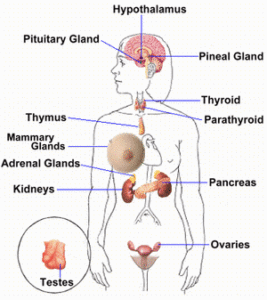Hormones
The female
Hormones are chemicals in the body which act as messengers to tell other parts of the body what to do. They are produced by specific organs in the body known as glands and they travel around the body in the bloodstream. Some hormones control the reproduction process; more information about the reproductive process can be found on the Reproductive System page.
Hormone production
- Hormone production begins in the brain where the Hypothalamus gland produces a hormone called Gonadotrophin Releasing Hormone (GnRH).
- GnRH then travels through the blood vessels to a gland nearby, called the Pituitary gland (which is also in the brain), where it stimulates the production of two hormones. These are known as Luteinising Hormone (LH) and Follicle Stimulating Hormone (FSH).
- FSH travels through the blood stream and causes the ovary to begin to produce a follicle which contains an egg. The follicle grows day by day until it is approximately two centimetres in diameter. FSH also causes the ovary to produce a hormone, oestrogen, which makes the lining of the womb grow and causes the mucus on the cervix to change so that it is receptive to sperm (i.e. they can swim through it more easily).
- LH levels in the blood increase very rapidly on about day 12-16 of the cycle (this is known as the LH surge). This surge makes the follicle rupture and release the egg (this is known as ovulation).
- When the egg has been released what is left of the follicle begins to produce the hormone progesterone and is now known as the corpus luteum. The progesterone supports the pregnancy, preventing a period (if pregnancy occurs) and also makes the lining of the womb secrete nutrients which are required by a developing embryo. The early embryo in turn secretes the pregnancy hormone hCG which maintains the corpus luteum.
The male
- Hormone production begins in the brain where the Hypothalamus gland produces a hormone called Gonadotrophin Releasing Hormone (GnRH).
- GnRH then travels through the blood vessels to a gland nearby, called the Pituitary gland (which is also in the brain), where it stimulates the production of two hormones. These are known as Luteinising Hormone (LH) and Follicle Stimulating Hormone (FSH).
- LH travels in the blood to the testicles where it stimulates specialist cells known as ‘Leydig’ cells to produce testosterone, which is essential for sperm production.
- FSH travels in the blood to the testicles where it stimulates sperm production.
